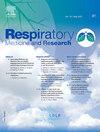肺动脉僵硬度是毛细管高压前后有效动脉弹性的主要相关因素。
IF 1.8
4区 医学
Q3 RESPIRATORY SYSTEM
引用次数: 0
摘要
背景:肺有效动脉弹性(EasPAP)的简化估计,定义为收缩期肺动脉(PA)压力除以卒中体积(SV),越来越多地用于量化肺动脉高压(PH)患者的总PA负荷及其与右心室的耦合,EasPAP升高与预后不良相关。尽管动脉弹性被认为更多地依赖于肺血管阻力(PVR)而不是刚度,但这种简化的临床推导估计的价值仍不清楚。方法:这项回顾性侵入性研究包括236名被诊断为特发性肺动脉高压(n = 118)或毛细血管后PH (n = 118)的成年人,年龄、性别和平均肺动脉压(mPAP)相匹配。PA总刚度定义为PA脉冲压力/SV。结果:在总体人群中(63%为女性,中位年龄70岁,mPAP 38 mmHg), EasPAP与僵硬度相关性最强(Spearman ρ=0.95)。在两组中观察到相同的结果,回归线显示相似的斜率和截距。这些相关性可以用收缩压和脉压之间可叠加的线性关系以及公式中共享的SV来解释。EasPAP与PVR的相关性较弱(ρ=0.83) (P < 0.0001),组间斜率和截距不同。同样的结果也被观察到,当下游压力被包括在弹性计算中,在最年轻的年龄的瓷砖。结论:在PH患者中,EasPAP与PA脉压/SV比(PA总僵硬度的标准临床估计)最密切相关。PA负荷的临床指标之间的这种重叠值得确认,表明右心室反应可能主要由搏动负荷驱动,具有潜在的治疗意义。本文章由计算机程序翻译,如有差异,请以英文原文为准。
Pulmonary arterial stiffness as the main correlate of effective arterial elastance in pre- and post-capillary pulmonary hypertension
Background
A simplified estimate of pulmonary effective arterial elastance (EasPAP), defined as systolic pulmonary artery (PA) pressure divided by stroke volume (SV), is increasingly used to quantify total PA load and its coupling with right ventricle in pulmonary hypertension (PH), with elevated EasPAP associated with worse prognosis. Although arterial elastance is thought to depend more on pulmonary vascular resistance (PVR) than on stiffness, the value of this simplified, clinically derived estimate remains unclear.
Methods
This retrospective invasive study included 236 adults diagnosed with idiopathic pulmonary arterial hypertension (n = 118) or post-capillary PH (n = 118), matched for age, sex, and mean PA pressure (mPAP). Total PA stiffness was defined as PA pulse pressure/SV.
Results
In the overall population (63 % women, median age 70 years, mPAP 38 mmHg), EasPAP correlated most strongly with stiffness (Spearman ρ=0.95). The same was observed in both groups, with regression lines showing similar slopes and intercepts. These correlations were explained by the superimposable linear relationships between systolic and pulse pressures, together with the shared SV in the formulas. EasPAP was less strongly associated with PVR (ρ=0.83) (P < 0.0001), with differing slopes and intercepts between groups. Similar results were observed when downstream pressure was included in elastance calculation, and in the youngest age tertile.
Conclusions
In PH patients, EasPAP most closely correlated with the PA pulse pressure/SV ratio, the standard clinical estimate of total PA stiffness. This overlap among clinical indices of PA load warrants recognition, suggesting right ventricular responses may be mainly driven by pulsatile load, with potential therapeutic implications.
求助全文
通过发布文献求助,成功后即可免费获取论文全文。
去求助
来源期刊

Respiratory Medicine and Research
RESPIRATORY SYSTEM-
CiteScore
2.70
自引率
0.00%
发文量
82
审稿时长
50 days
 求助内容:
求助内容: 应助结果提醒方式:
应助结果提醒方式:


